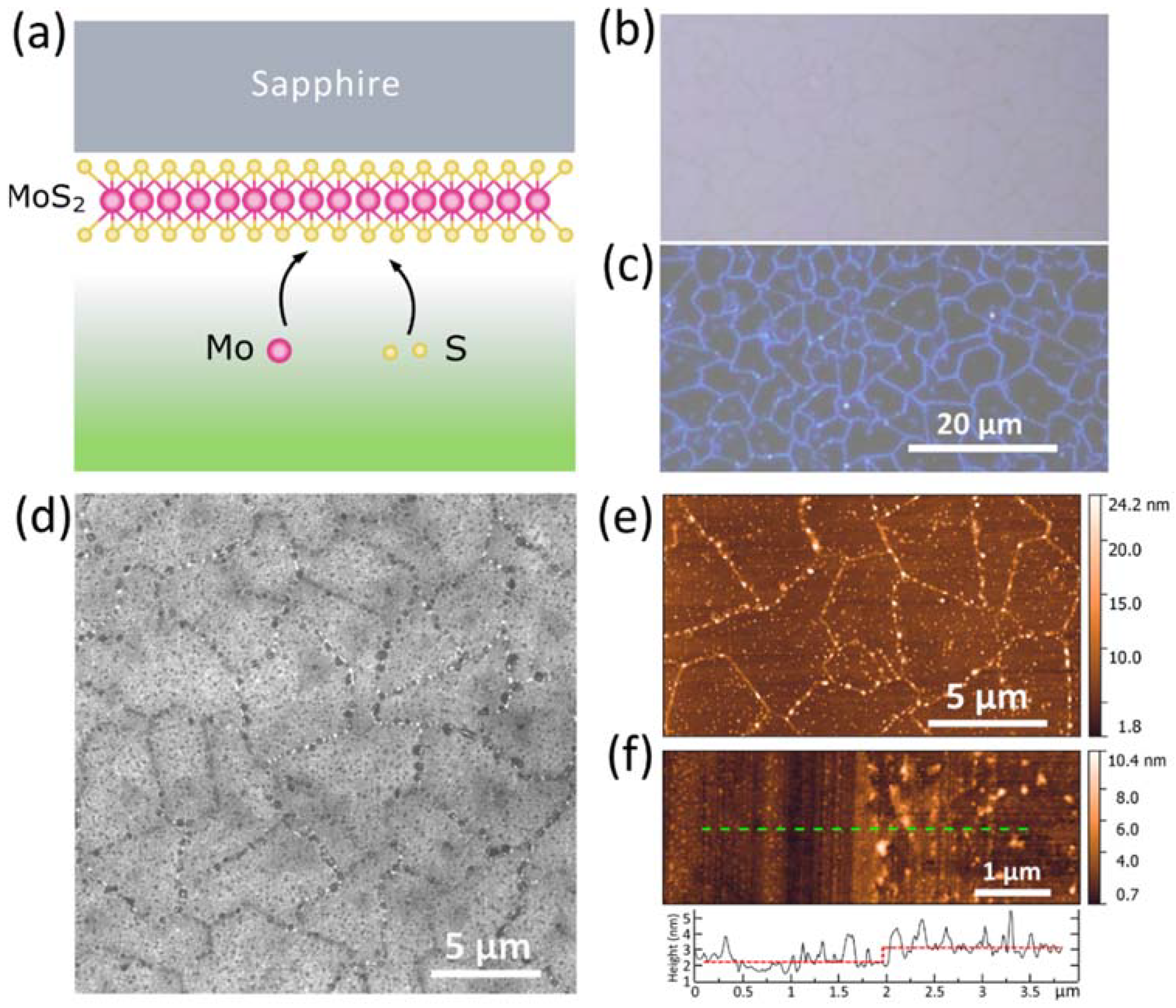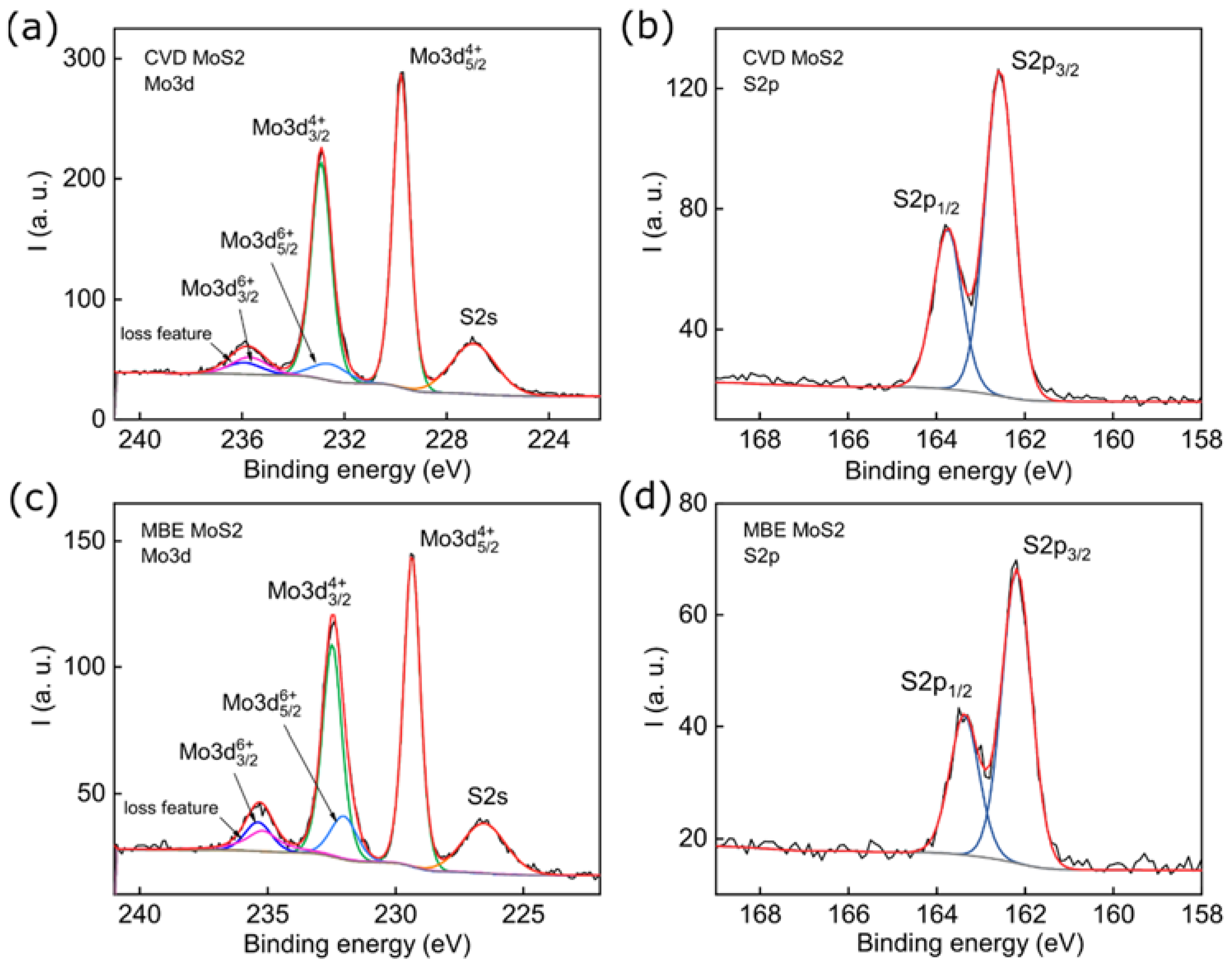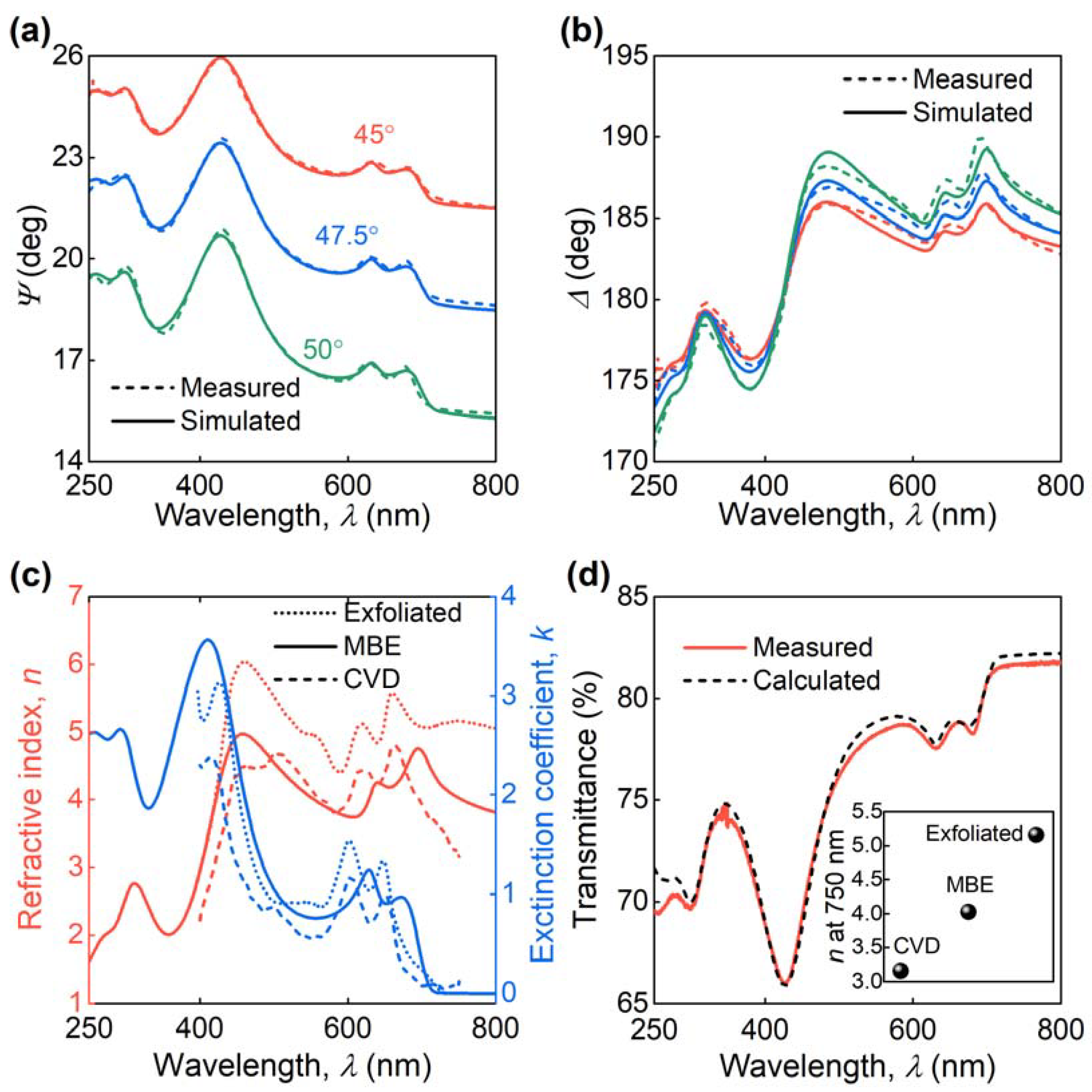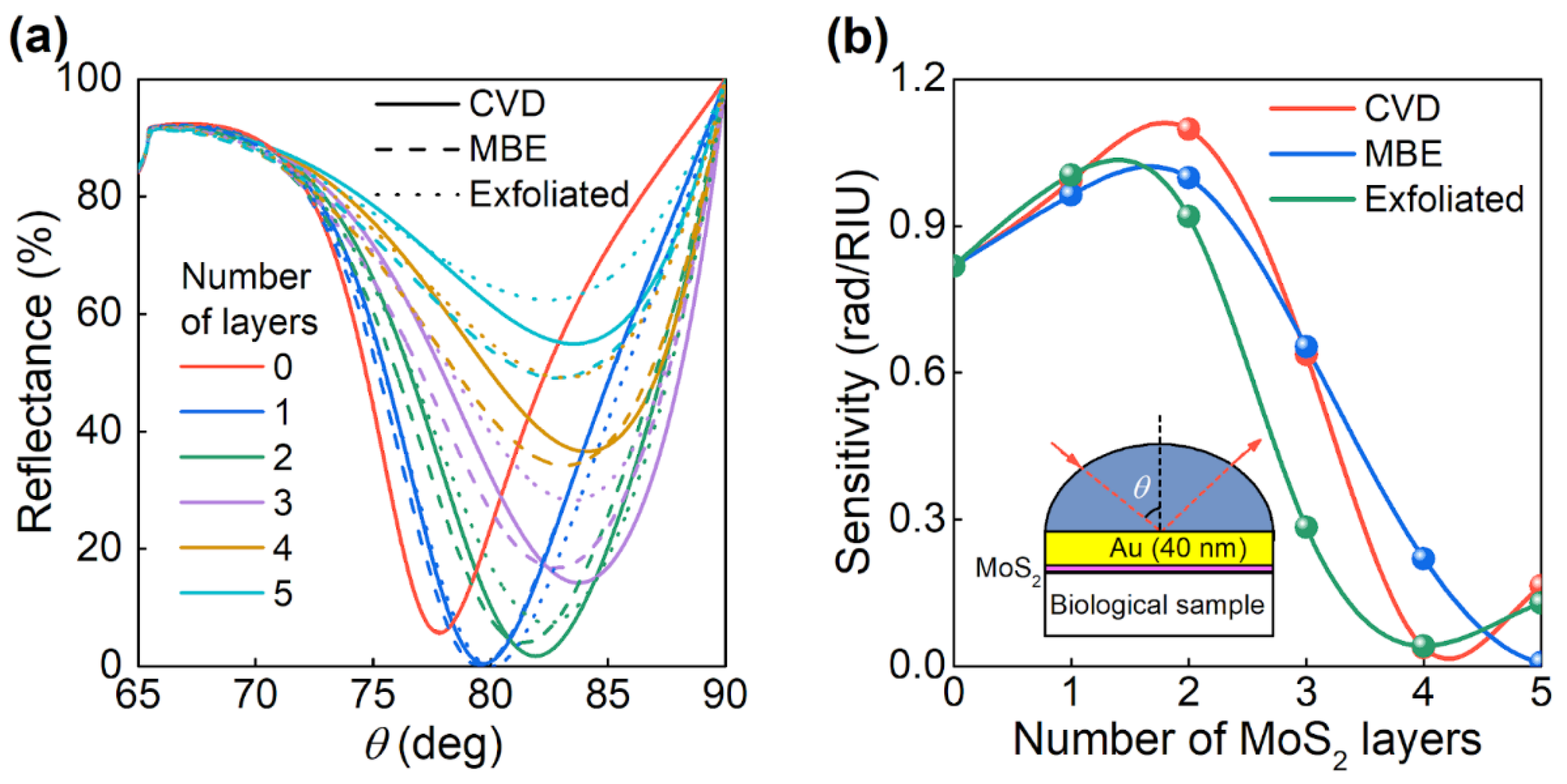Optical Constants and Structural Properties of Epitaxial MoS2 Monolayers
Abstract
1. Introduction
2. Results and Discussion
2.1. Sample Preparation and Characterization
2.2. Dielectric Response Analysis
3. Materials and Methods
3.1. Materials
3.2. Raman and Photoluminescence Characterization
3.3. X-ray Photoemission Spectroscopy Characterization
3.4. Atomic Force Microscopy, Optical Visualization, Scanning Electron Microscopy
3.5. Ellipsometry Characterization
4. Conclusions
Author Contributions
Funding
Institutional Review Board Statement
Informed Consent Statement
Data Availability Statement
Acknowledgments
Conflicts of Interest
Appendix A
| λ (nm) | n | k |
|---|---|---|
| 250 | 1.60684 | 2.61054 |
| 275 | 2.02921 | 2.55685 |
| 300 | 2.56575 | 2.58710 |
| 325 | 2.55812 | 1.89351 |
| 350 | 2.04339 | 2.16150 |
| 375 | 2.17595 | 2.89179 |
| 400 | 2.95143 | 3.48336 |
| 425 | 4.18875 | 3.38186 |
| 450 | 4.93334 | 2.40006 |
| 475 | 4.85958 | 1.51647 |
| 500 | 4.55210 | 1.04876 |
| 525 | 4.26415 | 0.83499 |
| 550 | 4.03556 | 0.75964 |
| 575 | 3.86255 | 0.77777 |
| 600 | 3.74944 | 0.90252 |
| 625 | 3.90919 | 1.22200 |
| 650 | 4.20291 | 0.90721 |
| 675 | 4.38497 | 0.96487 |
| 700 | 4.71574 | 0.32016 |
| 725 | 4.23306 | 0.00662 |
| 750 | 4.02327 | 0.00250 |
| 775 | 3.89866 | 0.00000 |
| 800 | 3.80981 | 0.00000 |
| 825 | 3.74192 | 0.00000 |
| 850 | 3.68740 | 0.00000 |
| 875 | 3.64225 | 0.00000 |
| 900 | 3.60403 | 0.00000 |
| 925 | 3.57116 | 0.00000 |
| 950 | 3.54254 | 0.00000 |
| 975 | 3.52215 | 0.00000 |
| 1000 | 3.49502 | 0.00000 |
| 1025 | 3.47888 | 0.00000 |
| 1050 | 3.45713 | 0.00000 |
| 1075 | 3.44403 | 0.00000 |
| 1100 | 3.42620 | 0.00000 |
| 1125 | 3.41536 | 0.00000 |
| 1150 | 3.40050 | 0.00000 |
| 1175 | 3.39140 | 0.00000 |
| 1200 | 3.37883 | 0.00000 |
| 1225 | 3.37110 | 0.00000 |
| 1250 | 3.36035 | 0.00000 |
| 1275 | 3.35371 | 0.00000 |
| 1300 | 3.34443 | 0.00000 |
| 1325 | 3.33867 | 0.00000 |
| 1350 | 3.33059 | 0.00000 |
| 1375 | 3.32556 | 0.00000 |
| 1400 | 3.31847 | 0.00000 |
| 1425 | 3.31404 | 0.00000 |
| 1450 | 3.30779 | 0.00000 |
| 1475 | 3.30387 | 0.00000 |
| 1500 | 3.29832 | 0.00000 |
| 1525 | 3.29482 | 0.00000 |
| 1550 | 3.28987 | 0.00000 |
| 1575 | 3.28674 | 0.00000 |
| 1600 | 3.28674 | 0.00000 |
| 1625 | 3.27949 | 0.00000 |
| 1650 | 3.27549 | 0.00000 |
| 1675 | 3.27296 | 0.00000 |
| 1700 | 3.26934 | 0.00000 |
References
- Novoselov, K.S.; Geim, A.K.; Morozov, S.V.; Jiang, D.; Zhang, Y.; Dubonos, S.V.; Grigorieva, I.V.; Firsov, A.A. Electric Field Effect in Atomically Thin Carbon Films. Science 2004, 306, 666–669. [Google Scholar] [CrossRef] [PubMed]
- Novoselov, K.S.; Mishchenko, A.; Carvalho, A.; Castro Neto, A.H. 2D Materials and van Der Waals Heterostructures. Science 2016, 353, aac9439. [Google Scholar] [CrossRef]
- Mak, K.F.; Shan, J. Photonics and Optoelectronics of 2D Semiconductor Transition Metal Dichalcogenides. Nat. Photonics 2016, 10, 216–226. [Google Scholar] [CrossRef]
- Datta, I.; Chae, S.H.; Bhatt, G.R.; Tadayon, M.A.; Li, B.; Yu, Y.; Park, C.; Park, J.; Cao, L.; Basov, D.N.; et al. Low-Loss Composite Photonic Platform Based on 2D Semiconductor Monolayers. Nat. Photonics 2020, 14, 256–262. [Google Scholar] [CrossRef]
- Tan, C.; Cao, X.; Wu, X.-J.; He, Q.; Yang, J.; Zhang, X.; Chen, J.; Zhao, W.; Han, S.; Nam, G.-H.; et al. Recent Advances in Ultrathin Two-Dimensional Nanomaterials. Chem. Rev. 2017, 117, 6225–6331. [Google Scholar] [CrossRef] [PubMed]
- Wang, Q.H.; Kalantar-Zadeh, K.; Kis, A.; Coleman, J.N.; Strano, M.S. Electronics and Optoelectronics of Two-Dimensional Transition Metal Dichalcogenides. Nat. Nanotechnol. 2012, 7, 699–712. [Google Scholar] [CrossRef]
- Peng, B.; Ang, P.K.; Loh, K.P. Two-Dimensional Dichalcogenides for Light-Harvesting Applications. Nano Today 2015, 10, 128–137. [Google Scholar] [CrossRef]
- Caldwell, J.D.; Aharonovich, I.; Cassabois, G.; Edgar, J.H.; Gil, B.; Basov, D.N. Photonics with Hexagonal Boron Nitride. Nat. Rev. Mater. 2019, 4, 552–567. [Google Scholar] [CrossRef]
- Li, D.; Gao, J.; Cheng, P.; He, J.; Yin, Y.; Hu, Y.; Chen, L.; Cheng, Y.; Zhao, J. 2D Boron Sheets: Structure, Growth, and Electronic and Thermal Transport Properties. Adv. Funct. Mater. 2020, 30, 1904349. [Google Scholar] [CrossRef]
- Ambrosi, A.; Sofer, Z.; Pumera, M. Electrochemical Exfoliation of Layered Black Phosphorus into Phosphorene. Angew. Chem. Int. Ed Engl. 2017, 56, 10443–10445. [Google Scholar] [CrossRef]
- Fleurence, A.; Friedlein, R.; Ozaki, T.; Kawai, H.; Wang, Y.; Yamada-Takamura, Y. Experimental Evidence for Epitaxial Silicene on Diboride Thin Films. Phys. Rev. Lett. 2012, 108, 245501. [Google Scholar] [CrossRef] [PubMed]
- Dávila, M.E.; Xian, L.; Cahangirov, S.; Rubio, A.; Le Lay, G. Germanene: A Novel Two-Dimensional Germanium Allotrope Akin to Graphene and Silicene. New J. Phys. 2014, 16, 095002. [Google Scholar] [CrossRef]
- Naguib, M.; Mochalin, V.N.; Barsoum, M.W.; Gogotsi, Y. 25th Anniversary Article: MXenes: A New Family of Two-Dimensional Materials. Adv. Mater. 2014, 26, 992–1005. [Google Scholar] [CrossRef]
- Jiang, X.; Kuklin, A.V.; Baev, A.; Ge, Y.; Ågren, H.; Zhang, H.; Prasad, P.N. Two-Dimensional MXenes: From Morphological to Optical, Electric, and Magnetic Properties and Applications. Phys. Rep. 2020, 848, 1–58. [Google Scholar] [CrossRef]
- Saito, Y.; Nojima, T.; Iwasa, Y. Highly Crystalline 2D Superconductors. Nat. Rev. Mater. 2017, 2, 16094. [Google Scholar] [CrossRef]
- da Jornada, F.H.; Xian, L.; Rubio, A.; Louie, S.G. Universal Slow Plasmons and Giant Field Enhancement in Atomically Thin Quasi-Two-Dimensional Metals. Nat. Commun. 2020, 11, 1013. [Google Scholar] [CrossRef]
- Zhao, S.; Hotta, T.; Koretsune, T.; Watanabe, K.; Taniguchi, T.; Sugawara, K.; Takahashi, T.; Shinohara, H.; Kitaura, R. Two-Dimensional Metallic NbS2: Growth, Optical Identification and Transport Properties. 2D Mater. 2016, 3, 025027. [Google Scholar] [CrossRef]
- Radisavljevic, B.; Radenovic, A.; Brivio, J.; Giacometti, V.; Kis, A. Single-Layer MoS2 Transistors. Nat. Nanotechnol. 2011, 6, 147–150. [Google Scholar] [CrossRef]
- Geim, A.K.; Grigorieva, I.V. Van Der Waals Heterostructures. Nature 2013, 499, 419–425. [Google Scholar] [CrossRef]
- Scuri, G.; Andersen, T.I.; Zhou, Y.; Wild, D.S.; Sung, J.; Gelly, R.J.; Bérubé, D.; Heo, H.; Shao, L.; Joe, A.Y.; et al. Electrically Tunable Valley Dynamics in Twisted WSe2/WSe2 Bilayers. Phys. Rev. Lett. 2020, 124, 217403. [Google Scholar] [CrossRef]
- Jariwala, D.; Sangwan, V.K.; Lauhon, L.J.; Marks, T.J.; Hersam, M.C. Emerging Device Applications for Semiconducting Two-Dimensional Transition Metal Dichalcogenides. ACS Nano 2014, 8, 1102–1120. [Google Scholar] [CrossRef]
- Choi, W.; Choudhary, N.; Han, G.H.; Park, J.; Akinwande, D.; Lee, Y.H. Recent Development of Two-Dimensional Transition Metal Dichalcogenides and Their Applications. Mater. Today 2017, 20, 116–130. [Google Scholar] [CrossRef]
- Yakubovsky, D.I.; Stebunov, Y.V.; Kirtaev, R.V.; Ermolaev, G.A.; Mironov, M.S.; Novikov, S.M.; Arsenin, A.V.; Volkov, V.S. Ultrathin and Ultrasmooth Gold Films on Monolayer MoS2. Adv. Mater. Interfaces 2019, 6, 1900196. [Google Scholar] [CrossRef]
- Ermolaev, G.A.; Grudinin, D.V.; Stebunov, Y.V.; Voronin, K.V.; Kravets, V.G.; Duan, J.; Mazitov, A.B.; Tselikov, G.I.; Bylinkin, A.; Yakubovsky, D.I.; et al. Giant Optical Anisotropy in Transition Metal Dichalcogenides for next-Generation Photonics. Nat. Commun. 2021, 12, 854. [Google Scholar] [CrossRef] [PubMed]
- Mak, K.F.; Lee, C.; Hone, J.; Shan, J.; Heinz, T.F. Atomically Thin MoS2: A New Direct-Gap Semiconductor. Phys. Rev. Lett. 2010, 105, 136805. [Google Scholar] [CrossRef]
- Amani, M.; Lien, D.-H.; Kiriya, D.; Xiao, J.; Azcatl, A.; Noh, J.; Madhvapathy, S.R.; Addou, R.; Kc, S.; Dubey, M.; et al. Near-Unity Photoluminescence Quantum Yield in MoS2. Science 2015, 350, 1065–1068. [Google Scholar] [CrossRef]
- Choudhury, T.H.; Zhang, X.; Al Balushi, Z.Y.; Chubarov, M.; Redwing, J.M. Epitaxial Growth of Two-Dimensional Layered Transition Metal Dichalcogenides. Annu. Rev. Mater. Res. 2020, 50, 155–177. [Google Scholar] [CrossRef]
- El Kazzi, S.; Mortelmans, W.; Nuytten, T.; Meersschaut, J.; Carolan, P.; Landeloos, L.; Conard, T.; Radu, I.; Heyns, M.; Merckling, C. MoS2 Synthesis by Gas Source MBE for Transition Metal Dichalcogenides Integration on Large Scale Substrates. J. Appl. Phys. 2018, 123, 135702. [Google Scholar] [CrossRef]
- Chang, L.L.; Ploog, K. (Eds.) Molecular Beam Epitaxy and Heterostructures; NATO ASI Series; Springer: Dordrecht, The Netherlands, 1985; ISBN 9789024731183. [Google Scholar]
- Li, W.; Birdwell, A.G.; Amani, M.; Burke, R.A.; Ling, X.; Lee, Y.-H.; Liang, X.; Peng, L.; Richter, C.A.; Kong, J.; et al. Broadband Optical Properties of Large-Area Monolayer CVD Molybdenum Disulfide. Phys. Rev. B 2014, 90, 195434. [Google Scholar] [CrossRef]
- Liu, H.-L.; Shen, C.-C.; Su, S.-H.; Hsu, C.-L.; Li, M.-Y.; Li, L.-J. Optical Properties of Monolayer Transition Metal Dichalcogenides Probed by Spectroscopic Ellipsometry. Appl. Phys. Lett. 2014, 105, 201905. [Google Scholar] [CrossRef]
- Kravets, V.G.; Prorok, V.V.; Poperenko, L.V.; Shaykevich, I.A. Ellipsometry and Optical Spectroscopy of Low-Dimensional Family TMDs. Semicond. Phys. Quantum Electron. Optoelectron. 2017, 20, 284–296. [Google Scholar] [CrossRef]
- Ghasemi, F.; Frisenda, R.; Dumcenco, D.; Kis, A.; Perez de Lara, D.; Castellanos-Gomez, A. High Throughput Characterization of Epitaxially Grown Single-Layer MoS2. Electronics 2017, 6, 28. [Google Scholar] [CrossRef]
- Yu, Y.; Yu, Y.; Cai, Y.; Li, W.; Gurarslan, A.; Peelaers, H.; Aspnes, D.E.; Van de Walle, C.G.; Nguyen, N.V.; Zhang, Y.-W.; et al. Exciton-Dominated Dielectric Function of Atomically Thin MoS2 Films. Sci. Rep. 2015, 5, 16996. [Google Scholar] [CrossRef] [PubMed]
- Fu, D.; Zhao, X.; Zhang, Y.-Y.; Li, L.; Xu, H.; Jang, A.-R.; Yoon, S.I.; Song, P.; Poh, S.M.; Tianhua, R.; et al. Molecular Beam Epitaxy of Highly Crystalline Monolayer Molybdenum Disulfide on Hexagonal Boron Nitride. J. Am. Chem. Soc. 2017, 139, 9392–9400. [Google Scholar] [CrossRef]
- Pacuski, W.; Grzeszczyk, M.; Nogajewski, K.; Bogucki, A.; Oreszczuk, K.; Kucharek, J.; Polczynska, K.E.; Seredynski, B.; Rodek, A.; Bozek, R.; et al. Narrow Excitonic Lines and Large-Scale Homogeneity of Transition-Metal Dichalcogenide Monolayers Grown by Molecular Beam Epitaxy on Hexagonal Boron Nitride. Nano Lett. 2020, 20, 3058–3066. [Google Scholar] [CrossRef] [PubMed]
- Zhang, H.; Ma, Y.; Wan, Y.; Rong, X.; Xie, Z.; Wang, W.; Dai, L. Measuring the Refractive Index of Highly Crystalline Monolayer MoS2 with High Confidence. Sci. Rep. 2015, 5, 8440. [Google Scholar] [CrossRef]
- Hsu, C.; Frisenda, R.; Schmidt, R.; Arora, A.; Vasconcellos, S.M.; Bratschitsch, R.; Zant, H.S.J.; Castellanos-Gomez, A. Thickness-Dependent Refractive Index of 1L, 2L, and 3L MoS2, MoSe2, WS2, and WSe2. Adv. Opt. Mater. 2019, 7, 1900239. [Google Scholar] [CrossRef]
- Ermolaev, G.A.; Stebunov, Y.V.; Vyshnevyy, A.A.; Tatarkin, D.E.; Yakubovsky, D.I.; Novikov, S.M.; Baranov, D.G.; Shegai, T.; Nikitin, A.Y.; Arsenin, A.V.; et al. Broadband Optical Properties of Monolayer and Bulk MoS2. npj 2D Mater. Appl. 2020, 4, 21. [Google Scholar] [CrossRef]
- Ermolaev, G.A.; Yakubovsky, D.I.; Stebunov, Y.V.; Arsenin, A.V.; Volkov, V.S. Spectral Ellipsometry of Monolayer Transition Metal Dichalcogenides: Analysis of Excitonic Peaks in Dispersion. J. Vac. Sci. Technol. B Nanotechnol. Microelectron. 2020, 38, 014002. [Google Scholar] [CrossRef]
- Tao, L.; Long, H.; Zhou, B.; Yu, S.F.; Lau, S.P.; Chai, Y.; Fung, K.H.; Tsang, Y.H.; Yao, J.; Xu, D. Preparation and Characterization of Few-Layer MoS2 Nanosheets and Their Good Nonlinear Optical Responses in the PMMA Matrix. Nanoscale 2014, 6, 9713–9719. [Google Scholar] [CrossRef]
- Lee, C.; Yan, H.; Brus, L.E.; Heinz, T.F.; Hone, J.; Ryu, S. Anomalous Lattice Vibrations of Single- and Few-Layer MoS2. ACS Nano 2010, 4, 2695–2700. [Google Scholar] [CrossRef]
- Li, H.; Wu, J.; Huang, X.; Lu, G.; Yang, J.; Lu, X.; Xiong, Q.; Zhang, H. Rapid and Reliable Thickness Identification of Two-Dimensional Nanosheets Using Optical Microscopy. ACS Nano 2013, 7, 10344–10353. [Google Scholar] [CrossRef] [PubMed]
- Lu, Y.; Chen, T.; Ryu, G.H.; Huang, H.; Sheng, Y.; Chang, R.-J.; Warner, J.H. Self-Limiting Growth of High-Quality 2D Monolayer MoS2 by Direct Sulfurization Using Precursor-Soluble Substrates for Advanced Field-Effect Transistors and Photodetectors. ACS Appl. Nano Mater. 2019, 2, 369–378. [Google Scholar] [CrossRef]
- Mak, K.F.; He, K.; Lee, C.; Lee, G.H.; Hone, J.; Heinz, T.F.; Shan, J. Tightly bound trions in monolayer MoS2. Nat. Mater. 2013, 12, 207–211. [Google Scholar] [CrossRef] [PubMed]
- Kaplan, D.; Gong, Y.; Mills, K.; Swaminathan, V.; Ajayan, P.M.; Shirodkar, S.; Kaxiras, E. Excitation Intensity Dependence of Photoluminescence from Monolayers of MoS2 and WS2 /MoS2 Heterostructures. 2D Mater. 2016, 3, 015005. [Google Scholar] [CrossRef]
- McDonell, S.; Addou, R.; Buie, C.; Wallace, R.M.; Hinkle, C.L. Defect-Dominated Doping and Contact Resistance in MoS2. ACS Nano 2014, 8, 2880–2888. [Google Scholar] [CrossRef] [PubMed]
- Chakraborty, B.; Ramakrishna Matte, H.S.; Sood, A.K.; Rao, C.N.R. Layer-Dependent Resonant Raman Scattering of a Few Layer MoS2. J. Raman Spectrosc. 2013, 44, 92–96. [Google Scholar] [CrossRef]
- Gao, J.; Li, B.; Tan, J.; Chow, P.; Lu, T.-M.; Koratkar, N. Aging of Transition Metal Dichalcogenide Monolayers. ACS Nano 2016, 10, 2628–2635. [Google Scholar] [CrossRef] [PubMed]
- Longo, R.C.; Addou, R.; Santosh, K.C.; Noh, J.-Y.; Smyth, C.M.; Barrera, D.; Zhang, C.; Hsu, J.W.P.; Wallace, R.M.; Cho, K. Intrinsic Air Stability Mechanisms of Two-Dimensional Transition Metal Dichalcogenide Surfaces: Basal versus Edge Oxidation. 2D Mater. 2017, 4, 025050. [Google Scholar] [CrossRef]
- Pető, J.; Ollár, T.; Vancsó, P.; Popov, Z.I.; Magda, G.Z.; Dobrik, G.; Hwang, C.; Sorokin, P.B.; Tapasztó, L. Spontaneous Doping of the Basal Plane of MoS2 Single Layers through Oxygen Substitution under Ambient Conditions. Nat. Chem. 2018, 10, 1246–1251. [Google Scholar] [CrossRef]
- Lu, H.; Kummel, A.; Robertson, J. Passivating the Sulfur Vacancy in Monolayer MoS2. APL Mater. 2018, 6, 066104. [Google Scholar] [CrossRef]
- Passler, N.C.; Paarmann, A. Generalized 4 × 4 Matrix Formalism for Light Propagation in Anisotropic Stratified Media: Study of Surface Phonon Polaritons in Polar Dielectric Heterostructures. J. Opt. Soc. Am. B 2017, 34, 2128. [Google Scholar] [CrossRef]
- Kretschmann, E.; Raether, H. Notizen: Radiative Decay of Non Radiative Surface Plasmons Excited by Light. Z. Nat. A 1968, 23, 2135–2136. [Google Scholar] [CrossRef]
- Stebunov, Y.V.; Arsenin, A.V.; Volkov, V.S. Chapter 12. Chemically Derived Graphene for Surface Plasmon Resonance Biosensing. In Chemically Derived Graphene: Functionalization, Properties and Applications; Nanoscience & Nanotechnology Series; Zhang, J., Ed.; Royal Society of Chemistry: London, UK, 2018; Volume 46, pp. 328–353. ISBN 9781788010801. [Google Scholar]
- Stebunov, Y.V.; Aftenieva, O.A.; Arsenin, A.V.; Volkov, V.S. Highly Sensitive and Selective Sensor Chips with Graphene-Oxide Linking Layer. ACS Appl. Mater. Interfaces 2015, 7, 21727–21734. [Google Scholar] [CrossRef] [PubMed]





| Oscillator | A (eV) | C (meV) | Eg (eV) | E0 (eV) |
|---|---|---|---|---|
| #1 | 410 | 120 | 1.718 | 1.787 |
| #2 | 84 | 88 | 1.832 | 1.955 |
| #3 | 77 | 600 | 1.565 | 2.872 |
| #4 | 80 | 731 | 2.856 | 4.070 |
| #5 | 281 | 826 | 4.135 | 4.504 |
Publisher’s Note: MDPI stays neutral with regard to jurisdictional claims in published maps and institutional affiliations. |
© 2021 by the authors. Licensee MDPI, Basel, Switzerland. This article is an open access article distributed under the terms and conditions of the Creative Commons Attribution (CC BY) license (https://creativecommons.org/licenses/by/4.0/).
Share and Cite
Ermolaev, G.A.; El-Sayed, M.A.; Yakubovsky, D.I.; Voronin, K.V.; Romanov, R.I.; Tatmyshevskiy, M.K.; Doroshina, N.V.; Nemtsov, A.B.; Voronov, A.A.; Novikov, S.M.; et al. Optical Constants and Structural Properties of Epitaxial MoS2 Monolayers. Nanomaterials 2021, 11, 1411. https://doi.org/10.3390/nano11061411
Ermolaev GA, El-Sayed MA, Yakubovsky DI, Voronin KV, Romanov RI, Tatmyshevskiy MK, Doroshina NV, Nemtsov AB, Voronov AA, Novikov SM, et al. Optical Constants and Structural Properties of Epitaxial MoS2 Monolayers. Nanomaterials. 2021; 11(6):1411. https://doi.org/10.3390/nano11061411
Chicago/Turabian StyleErmolaev, Georgy A., Marwa A. El-Sayed, Dmitry I. Yakubovsky, Kirill V. Voronin, Roman I. Romanov, Mikhail K. Tatmyshevskiy, Natalia V. Doroshina, Anton B. Nemtsov, Artem A. Voronov, Sergey M. Novikov, and et al. 2021. "Optical Constants and Structural Properties of Epitaxial MoS2 Monolayers" Nanomaterials 11, no. 6: 1411. https://doi.org/10.3390/nano11061411
APA StyleErmolaev, G. A., El-Sayed, M. A., Yakubovsky, D. I., Voronin, K. V., Romanov, R. I., Tatmyshevskiy, M. K., Doroshina, N. V., Nemtsov, A. B., Voronov, A. A., Novikov, S. M., Markeev, A. M., Tselikov, G. I., Vyshnevyy, A. A., Arsenin, A. V., & Volkov, V. S. (2021). Optical Constants and Structural Properties of Epitaxial MoS2 Monolayers. Nanomaterials, 11(6), 1411. https://doi.org/10.3390/nano11061411








